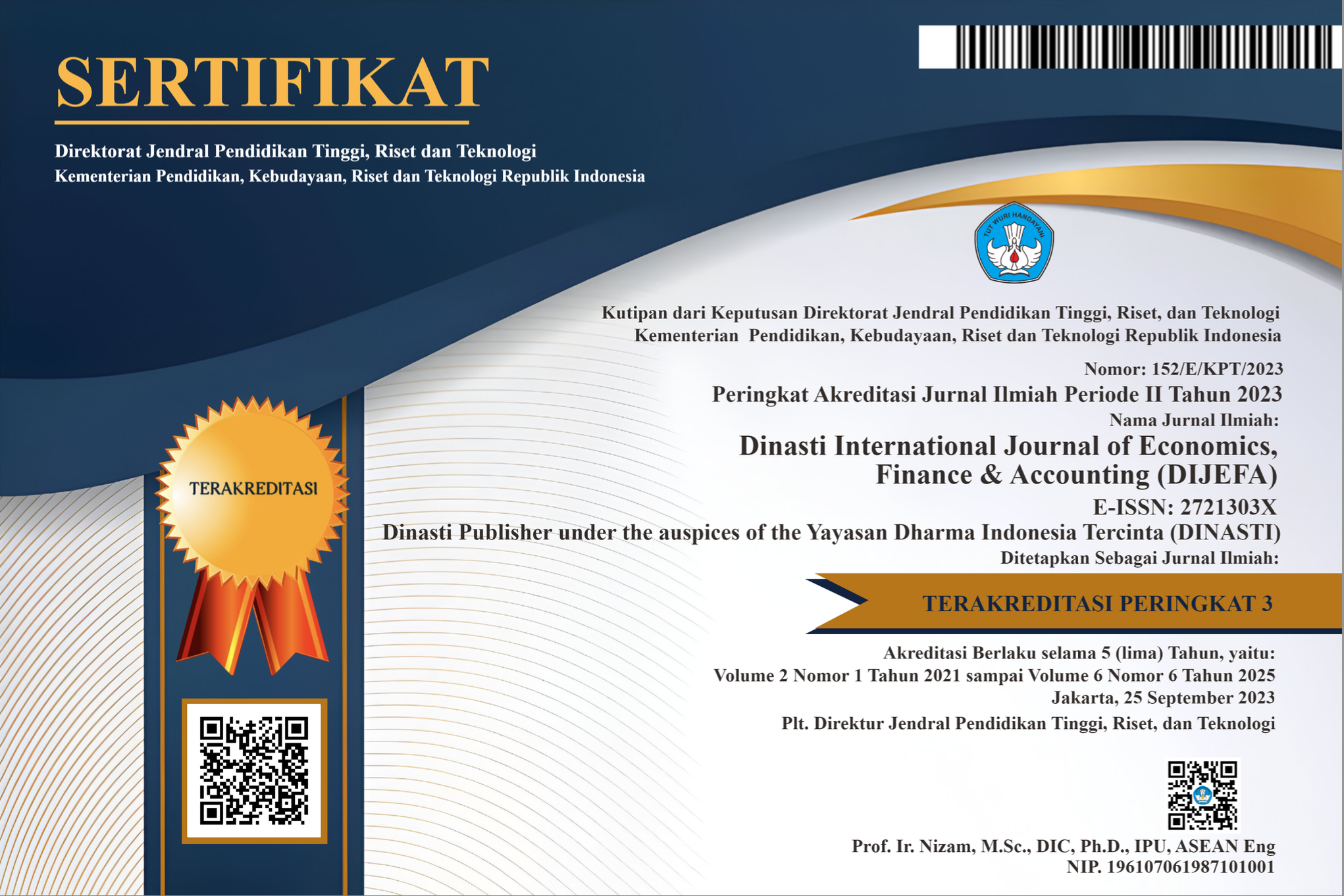Analysis of Corporate Governance, Intellectual Capital, and Financial Performance Using Conventional Methods and Maqashid Sharia Index (MSI) on the Implementation of Sustainable Finance in Sharia Banking in Indonesia
DOI:
https://doi.org/10.38035/dijefa.v3i4.1430Keywords:
Financial Sustainability, Good Corporate Governance, Intellectual Capital, Financial Performance, Maqashid Syariah Index (MSI)Abstract
The banking industry certainly has a role to play in the success of this initiative through a sustainable finance program. Sustainable finance is a global trend that represents a new paradigm in the world of banking and other financial institutions that help implement sustainable development. Sustainable development is a development effort based on three directions: benefits, society, and protection of natural resources and the environment. In this study, the authors use traditional methods and the Makassid Shariah Index (MSI) to assess the impact of corporate governance, intellectual capital, and financial performance on sustainable financial practices in the Indonesian Islamic financial services industry. 2017-2021 (5 years). The sample of this research is processed from the annual report data of Islamic banks in Indonesia by using the panel data regression analysis method. Based on this research, the influence of corporate governance, intellectual capital, and financial performance using traditional methods and the Makassid Shariah Index (MSI) is shown in the practice of sustainable finance. The independent variable, GCG, is determined by the composite self-assessment score of each Islamic bank, value added intellectual capital (VAIC), financial performance and return on investment (ROA), net funding (NPF), and the Makassid Shariah Index (MSI) and the dependent variable, sustainable financing, is approximated by the Financial Sustainability Ratio (FSR). A study of Islamic banks in Indonesia also shows that the GCG, VAIC, ROA, NPF, and MSI variables all have a positive effect on the FSR variable, with an R-squared model value of 0.9959. variables in this study.
References
Ahmad, H. (2005). Islamic Currency. Jakarta: Grafindo Persada.
Al Arif, MNR (2021). Islamic banking marketing basics.
Al Ghifari, M., Handoko, LH, & Yani, EA (2015). Analysis of Islamic Banking Performance in Indonesia and Malaysia with the Maqashid Index Approach. Journal of Islamic Banking and Economics, 3(2), 47–66.
Alim, M., & Sina, DI (2020). Effect of Capital Adequacy Ratio, Non-Performing Financing and Net Profit on Financial Sustainability Ratio (On Islamic Banking Companies In Indonesia 2014-2018 Period). Balance Vocational Accounting Journal, 4(1), 28–42.
Almilia, LS, Shonhadji, N., & Angraini. (2009). Factors Affecting Financial Sustainability Ratio in Non-Foreign Exchange National Private Commercial Banks 1995-2005 Period. Journal of Accounting and Finance, 11(1), 42–52. http://puslit2.petra.ac.id/ejournal/index.php/aku/article/view/17865
Amouzesh, N., Moeinfar, Z., & Mousavi, Z. (2011). Sustainable growth rate and firm performance: Evidence from Iran Stock Exchange. International Journal of Business and Social Science, 2(23).
Antonio, MS (2002). Islamic Banks: Analysis of strengths, weaknesses, opportunities and threats. Yogyakarta: Econesia.
Auda, J. (2013). al-Maqasid for Beginners. Yogyakarta: Like Press Uin Sunan Kalijaga.
Ayayi, AG, & Sene, M. (2010). What drives microfinance institution's financial sustainability. The Journal of Developing Areas, 303–324.
Daraba, D., Wirawan, H., Salam, R., & Faisal, M. (2021). Working from home during the corona pandemic: Investigating the role of authentic leadership, psychological capital, and gender on employee performance. Cogent Business and Management, 8(1). https://doi.org/10.1080/23311975.2021.1885573
Fakhiroh, SZ, & Hariasih, M. (2021). Effect of Capital Adequacy Ratio, Non Performing Loan and Loan to Deposit Ratio on Return On Assets in Banks listed on the Indonesia Stock Exchange for the 2015-2019 Period. Indonesian Journal of Innovation Studies, 16, 10–21070.
Ferrare, JJ, & Miller, JM (2020). Making sense of persistence in scientific purgatory: A multi-institutional analysis of instructors in introductory science, technology, engineering, and mathematics (STEM) courses. The Journal of Higher Education, 91(1), 113–138.
Firer, S., & Mitchell Williams, S. (2003). Intellectual capital and traditional measures of corporate performance. Journal of Intellectual Capital, 4(3), 348–360. https://doi.org/10.1108/14691930310487806
Giannini, NG (2013). Factors influencing Mudharabah financing in Islamic commercial banks in Indonesia. Accounting Analysis Journal, 2(1).
Jeucken, M. (2010). Sustainable finance and banking: The financial sector and the future of the planet. Routledge.
John, K., Litov, L., & Yeung, B. (2008). Corporate governance and risk-taking. The Journal of Finance, 63(4), 1679–1728.
Jundiani, J. (2009). Sharia banking law regulation in Indonesia. UIN Maliki Press.
Kubo, I., & Saka, A. (2002). An inquiry into the motivations of knowledge workers in the Japanese financial industry. Journal of Knowledge Management, 6(3), 262–271. https://doi.org/10.1108/13673270210434368
Mohammed, MO, & Taib, FM (2016). The performance measurement of Islamic banking based on the maqasid framework. In Islamic Financial Economy and Islamic Banking (pp. 108–127). Routledge.
Monks, J. (2003). Patterns of giving to one's alma mater among young graduates from selective institutions. Economics of Education Review, 22(2), 121–130. https://doi.org/10.1016/S0272-7757(02)00036-5
Mutia, E., & Musfirah, N. (2017). Maqashid Shariah Index Approach as a Performance Measurement of Islamic Banking in Southeast Asia. Indonesian Journal of Accounting and Finance, 14(2), 181–201. https://doi.org/10.21002/jaki.2017.10
Nabwonya, D., Wafula, W., Musiega, M., Wafula, DN, Shedrack, D., Mutua, M., Maniagi, M., & Musiega, G. (2016). INFLUENCE OF FINANCIAL PERFORMANCE ON FINANCIAL SUSTAINABILITY OF MICROFINANCE INSTITUTIONS IN KENYA Determinants of financial sustainability of microfinance institutions in kenya View project INFLUENCE OF FINANCIAL PERFORMANCE ON FINANCIAL SUSTAINABILITY OF MICROFINANCE INSTITUTIONS IN KENYA. International Journal of Management and Commerce Innovations, 4(October), 295–302. https://www.researchgate.net/publication/309479311
Nawaz, T., & Haniffa, R. (2017). Determinants of financial performance of Islamic banks: an intellectual capital perspective. Journal of Islamic Accounting and Business Research, 8(2), 130–142. https://doi.org/10.1108/JIABR-06-2016-0071
Notoatmojo, MI (2016). Analysis of the Factors Affecting the Financial Sustainability Ratio at Islamic Commercial Banks in Indonesia for the 2010-2014 Period. Holy STAIN.
Pulic, A. (2000). VAICTM–an accounting tool for IC management. International Journal of Technology Management, 20(5–8), 702–714.
Pulic, A. (1998). Measuring the performance of intellectual potential in the knowledge economy. 2nd McMaster Word Congress on Measuring and Managing Intellectual Capital by the Austrian Team for Intellectual Potential, 1–20.
Puspitasari, D. (2019). Comparison of the Effect of Company Performance and Company Value on Sustainable Growth Rates. Al Tijarah, 5(1), 24. https://doi.org/10.21111/tijarah.v5i1.3325
Rahma, Y. (2018). The Effect Of Intellectual Capital And Islamic Performance Index On Financial Performance. Accountability, 11(1), 105–116. https://doi.org/10.15408/akt.v11i1.8804
Ramadhan, MIB, Abdurahim, A., & Sofyani, H. (2019). Intellectual Capital and Performance of Islamic Maqashid Islamic Banking in Indonesia. Journal of Islamic Accounting and Finance, 6(1), 5–18. https://doi.org/10.35836/jakis.v6i1.6
Rianasari, S., & Pangestuti, IRD (2016). ANALYSIS OF FINANCIAL PERFORMANCE RATIO TO FINANCIAL SUSTAINABILITY OF PEOPLE'S CREDIT BANK (BPR) IN CENTRAL JAVA (2010-2014 Period). Diponegoro Journal of Management, 5(2), 575–589.
Saputri, KO (2019). Financial Performance on the Company's Sustainability Capability. Journal of Contemporary Accounting Research, 11(1), 24–32. https://doi.org/10.23969/jrak.v11i1.1869
Saputro, AW, & Purwanto, A. (2013). The Effect of Performance, Liquidity and Stock Returns on Deviation Actual Growth Rate from Sustainable Growth Rate. In the XVI National Accounting Symposium: Vol. I.
Sarwono, AE, & Sunarko, MR (2015). The Effect of Financial Ratio Variables on Financial Sustainability Ratio in Mixed Banks for the Period 2011-2013. Exploration, XXVII(2), 540–549. https://ejurnal.unisri.ac.id/index.php/Explorasi/article/view/1171
Shaukat, M., & FerosKhan, HC (2018). Measuring The Financial Growth of Islamic Banks and The Compliance to Maqasid Al-Shariah: An Industry Wide Assessment. Working Paper for College of Banking & Financial Studies, 104 (16), 1–16.
Sholikah, AM and TM (2021). Factors Influence Financial Sustainability Banking in Indonesia. Al-Tijary: Journal of Islamic Economics and Business, 6(1), 41–50. http://repository.uin-malang.ac.id/8334/
Ulum, I., Ghozali, I., & Chariri, A. (2008). Intellectual capital and financial performance of the company; An analysis with Partial Least Squares (PLS) approach.
Wahid, NN, Firmansyah, I., & Fadillah, AR (2018). Performance Analysis of Islamic Banks with Maqashid Syariah Index (MSI) and Profitability. Journal of Accounting, 13(1), 1–9.
Wahyuni, S., & Fakhruddin, I. (2014). Analysis of Factors Affecting the Sustainability Ratio of Islamic Banking in Indonesia.
Downloads
Published
How to Cite
Issue
Section
License
Authors who publish their manuscripts in this journal agree to the following conditions:
- The copyright on each article belongs to the author(s).
- The author acknowledges that the Dinasti International Journal of Economics, Finance & Accounting (DIJEFA) has the right to be the first to publish with a Creative Commons Attribution 4.0 International license (Attribution 4.0 International (CC BY 4.0).
- Authors can submit articles separately, arrange for the non-exclusive distribution of manuscripts that have been published in this journal into other versions (e.g., sent to the author's institutional repository, publication into books, etc.), by acknowledging that the manuscript has been published for the first time in the Dinasti International Journal of Economics, Finance & Accounting (DIJEFA).


























































